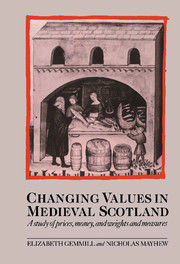Book contents
- Frontmatter
- Contents
- List of figures
- List of tables
- Preface
- List of abbreviations
- Introduction
- 1 Price trends in medieval Scotland
- 2 Prices in medieval Aberdeen
- 3 Weights and measures
- 4 Currency
- 5 The price of victual and needful merchandise
- 6 Prices and the Scottish economy, 1260–1540
- Glossary of unusual terms
- Select bibliography
- Index
3 - Weights and measures
Published online by Cambridge University Press: 23 September 2009
- Frontmatter
- Contents
- List of figures
- List of tables
- Preface
- List of abbreviations
- Introduction
- 1 Price trends in medieval Scotland
- 2 Prices in medieval Aberdeen
- 3 Weights and measures
- 4 Currency
- 5 The price of victual and needful merchandise
- 6 Prices and the Scottish economy, 1260–1540
- Glossary of unusual terms
- Select bibliography
- Index
Summary
item anent mettis and mesuris it is sene speidfull that sen we haif bot a king and a lawe vniuersale throu out the Realme we sulde haif bot a met and mesur' generale to serue all the Realme.
In order to be able to compare prices, we need to examine the various weights, measures, containers, and other units in which commodities were exchanged or valued. As will be seen from the Glossary, medieval Scotland knew a rich variety of weights and measures, and within each commodity series we find a number of different units. Wine, which had to be carried from abroad, and was sold in divers quantities, is the commodity for which we have met the greatest number of different vessels: tuns, pipes, puncheons, tersans, hogsheads, casks, vases, rubbours, gallons, pints, choppins, and mutchkins are all found. Yet to enable us to compare individual entries for each commodity we have, as far as possible, expressed our unit prices in terms of the unit found most commonly for that commodity. This process is by no means complete, for a number of reasons. First, it has not always been clear to us what the size or weight of a particular unit was. Secondly, although we may have found some evidence to indicate the size or weight of a unit on a particular occasion, we may not be confident that it was always of that size or weight. And finally, we believe that some units were simply not intended to represent specific quantities. The Glossary sets out the evidence on which our assumptions about the size or weight of individual units are based, and also explains which units have not been established as having a fixed size or relationship with others.
Information
- Type
- Chapter
- Information
- Changing Values in Medieval ScotlandA Study of Prices, Money, and Weights and Measures, pp. 81 - 110Publisher: Cambridge University PressPrint publication year: 1995
